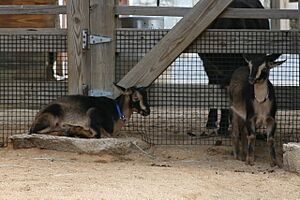San Clemente Island goat facts for kids
The San Clemente Island goat is a special kind of goat. These goats lived in the wild on San Clemente Island. This island is one of the Channel Islands off the coast of California. They became a unique type of goat because they were isolated there for a long time.

History of the San Clemente Goats
The wild goats on the Channel Islands have a long history. Experts believe they are descendants of goats brought by Spanish missionaries and settlers. These first goats came from Spain. They arrived on San Clemente Island from Santa Catalina Island in 1875.
The goats lived freely on San Clemente Island for many years. However, the United States Navy needed to protect rare plants and animals on the island. These native species were being harmed by the goats eating their food. The Navy tried to remove the goats.
At first, they tried to trap and hunt the goats. When this did not work, the Navy started a program to remove them by shooting. A group called the Fund for Animals disagreed with this plan. They went to court to stop the Navy. The Fund for Animals believed the goats were not harming the endangered species. However, the plants and animals were indeed listed as endangered. They were protected by the Endangered Species Act.
Some goats were offered for adoption to families on the mainland. The U.S. Navy was eventually allowed to remove the remaining goats. The very last goat on San Clemente Island was removed in April 1991.
What Makes San Clemente Goats Special?
San Clemente Island goats are small and have thin bones. They look a bit like deer. Male goats have unique horns that twist outwards. Both male and female goats have horns.
Even though their horns look like those of Spanish goats, DNA studies show they are not related to Spanish breeds. In 2007, The Livestock Conservancy and the University of Cordoba in Spain studied their DNA. They found that the San Clemente goat is a truly unique breed.
These goats are considered a critically endangered heritage breed. This means they are very rare and important to protect. The Livestock Conservancy lists them as a top priority for conservation. In 2020, there were only about 1,400 San Clemente goats left in the world. They now live on the mainland in the U.S.A. and in Canada.

